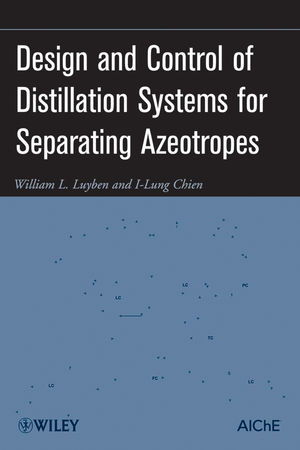Design and Control of Distillation Systems for Separating AzeotropesISBN: 978-0-470-44862-5
Hardcover
472 pages
April 2010
 This is a Print-on-Demand title. It will be printed specifically to fill your order. Please allow an additional 10-15 days delivery time. The book is not returnable.
|
||||||
ACKNOWLEDGEMENTS.
PART 1 FUNDAMENTALS AND TOOLS.
1 INTRODUCTION.
1.1 History.
1.2 Applications.
1.3 Literature.
1.4 Multiple Steady States.
References.
2 PHASE EQUILIBRIUM.
2.1 Phase Equilibrium Relationships.
2.2 Equations Describing Phase Equilibrium Relationships.
2.3 Diagrams For Binary Systems.
2.4 Ternary Diagrams.
2.5 Data Regression.
2.6 Group Contribution Method.
2.7 Conclusion.
References.
3 STEADY-STATE DESIGN IN ASPEN PLUS.
3.1 Building a Steady-State Model.
3.2 Unit Operation Blocks Used in this Book.
3.3 Add a Nondatabank Component.
3.4 Conclusion.
References.
4 DYNAMICS AND CONTROL IN ASPEN DYNAMICS.
4.1 Sizing of Process Vessels.
4.2 Sizing of Pumps, Compressors, and Control Valves.
4.3 Controllers and Dynamic Elements.
4.4 Controller Tuning.
4.5 Ratio and Cascade Control.
4.6 Conclusion.
PART 2 SEPARATIONS WITHOUT ADDING OTHER COMPONENTS.
5 PRESSURE-SWING AZEOTROPIC DISTILLATION.
5.1 Tetrahydrofuran–Water System.
5.2 Acetone–Methanol System.
5.3 Pentane–Methanol System.
5.4 Conclusion.
References.
6 PRESSURE SWING WITH HEAT INTEGRATION.
6.1 THF–Water System Steady-State Design with Heat Integration.
6.2 THF–Water System Dynamics and Control.
6.3 Heat Integration in an Acetone–Methanol System.
6.4 Conclusion.
References.
7 HETEROGENEOUS BINARY AZEOTROPES.
7.1 n-Butanol-Water System.
7.2 Phase Equilibrium.
7.3 Steady-State Design.
7.4 Dynamics and Control.
7.5 Conclusion.
References.
PART 3 SEPARATIONS USING A LIGHT ENTRAINER (HETEROGENEOUS AZEOTROPIC DISTILLATION).
8 ISOPROPANOL–WATER (CYCLOHEXANE AS THE ENTRAINER).
8.1 Feasible Column Sequence for the Separation.
8.2 Steady-State Design of an Isopropanol–Water System.
8.3 Overall Control Strategy Development.
8.4 Conclusion.
References.
9 ACETIC ACID–WATER (ISOBUTYL ACETATE AS THE ENTRAINER).
9.1 Comparison of Three Candidate Entrainers.
9.2 Control Strategy Development.
9.3 Industrial Column with Preliminary Dynamic Simulations.
9.4 Industrial Column with Continuous Side-Stream Draw Off.
9.5 Side Draw with a Practical Automatic Purging Strategy.
9.6 Conclusion.
References.
PART 4 SEPARATIONS USING HEAVY ENTRAINER (EXTRACTIVE DISTILLATION).
10 ISOPROPANOL-WATER (DIMETHYL SULFOXIDE AS THE ENTRAINER).
10.1 Comparing Entrainers: Dimethyl Sulfoxide Versus Ethylene Glycol.
10.2 Steady-State Design and Economical Analysis.
10.3 Overall Control Strategy Development.
10.4 Conclusion.
References.
11 EXTRACTIVE DISTILLATION OF THE ACETONE-METHANOL SYSTEM.
11.1 Acetone–Methanol–Water Phase Equilibrium.
11.2 Steady-State Design.
11.3 Dynamics and Control.
11.4 Heat-Integrated System.
11.5 Effect of Solvent on Controllability.
11.6 Conclusion.
References.
12 MAXIMUM-BOILING AZEOTROPES.
12.1 Acetone–Chloroform System Steady-State Design.
12.2 Dynamics and Control.
12.3 Conclusion.
Reference.
PART 5 OTHER WAYS FOR SEPARATING AZEOTROPES.
13 BATCH DISTILLATION OF AZEOTROPES.
13.1 Batch Extractive Distillation (Acetone–Methanol with Water as the Entrainer).
13.2 Batch Extractive Distillation (Isopropanol–Water with DMSO as the Entrainer).
13.3 Acetic Acid Dehydration Via Heteroazeotropic Batch Distillation.
13.4 Multivessel Heteroazeotropic Batch Distillation.
13.5 Conclusion.
References.
14 HYBRID DISTILLATION–PERVAPORATION SYSTEMS.
14.1 Introduction.
14.2 Pervaporation Model.
14.3 Pervaporation–Column System.
14.4 Dynamics and Control.
14.5 Process Modification.
14.6 Conclusion.
References.
INDEX.



